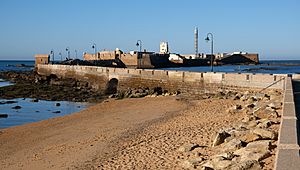Castle of San Sebastián (Cádiz) facts for kids
Quick facts for kids Castle of San Sebastián |
|
|---|---|
| Native name Spanish: Castillo de San Sebastián |
|
 |
|
| Location | Cádiz, Spain |
| Official name: Castillo de San Sebastián | |
| Type | Non-movable |
| Criteria | Monument |
| Designated | 1993 |
| Reference no. | RI-51-0007575 |
| Lua error in Module:Location_map at line 420: attempt to index field 'wikibase' (a nil value). | |
The Castle of San Sebastián (in Spanish: Castillo de San Sebastián) is a strong fortress in Cádiz, Spain. It stands on a small island at the end of La Caleta beach. This island is separate from the main city. In 1993, it was recognized as an important cultural site called Bien de Interés Cultural.
Contents
History of the Castle
Ancient Beginnings
Long ago, people believed that a temple stood where the fortress is now. This temple was dedicated to Kronos. Kronos was a powerful Titan from ancient Greek myths. He was known as the father of many famous Greek gods, including Zeus, Poseidon, and Hades.
Early Structures
In 1457, something new was built on the island. A group of sailors from Venice built a small chapel there. They had been sick with the plague and built the chapel as a thank you for getting better.
Building the Fortress
The main castle was built much later, in 1706. It was designed to be a strong, fortified area. The castle had an unusual shape. Its main job was to protect the northern part of the city of Cádiz from attacks. There was also an old watchtower from the Muslim period. This tower was located at the base of where the lighthouse now stands.
Notable Prisoners
The castle has also been used as a prison. In 1811, a person named Juan Bautista Azopardo was brought there. He was a famous prisoner from Buenos Aires. He stayed in the fortress until 1815. After that, he was moved to a military prison in Ceuta.
Connecting to the City
Over time, people wanted to make it easier to reach the island. So, in 1860, a special walkway was built. This walkway is called a levee. It connects the island directly to the city of Cádiz.
The Lighthouse
The castle is also home to an important lighthouse. This lighthouse has an iron structure. It was designed by Rafael de la Cerda in 1908. This lighthouse was very modern for its time. It was the second lighthouse in Spain to be powered by electricity. The top of the lighthouse stands 41 meters (about 135 feet) above the sea.
Cultural Recognition
The Castillo de San Sebastián is a very important historical site. In 1985, it was officially declared a cultural landmark. This means it is protected and valued for its history and beauty.
See also
 In Spanish: Castillo de San Sebastián (Cádiz) para niños
In Spanish: Castillo de San Sebastián (Cádiz) para niños

